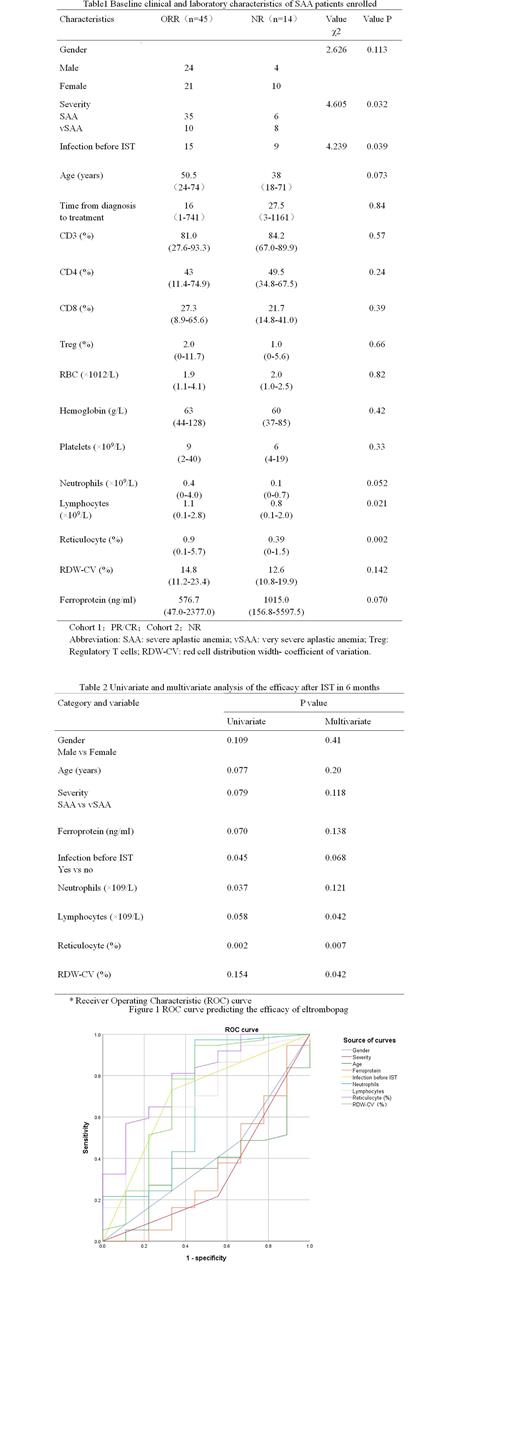Abstract
Prospective trials showed the clinical efficacy of eltrombopag in refractory/relapsed aplastic anemia (AA), with up to 40% hematologic improvement [1]. Moreover, eltrombopag was combined with frontline immunosupressive therapy (IST) consisited of antithymocyte immunoglobulin (ATG) and cyclosporin (CsA), with an overall response rate exceeding 80% [2]. The metabolism of eltrodopag is different in disparate population. Currently, the recommended dose is 75 mg/d for East Asian populations [2], Pretreatment clinical and laboratory characteristics predicting eltrombopag response are still unclear in severe AA (SAA) patients of real-world in East Asian.
From May 2014 to December 2020, 59 adult SAA patients were treated with IST (r-ATG, 3.5mg/kg/d × 5d and CsA 3-5 mg/kg/d) in conjunction with eltrodopag at the dose of 75 mg/d from day 1 until 6 months. We used Receiver Operating Characteristic (ROC) curve to predict the factors of the efficacy of eltrombopag.
Median follow-up was 13 months (6 month to 29 months). Overall 45 patients (76%) responded to eltrombopag, including 16 patients (27%) who achieved complete response (CR) and 29 patients (49%) who achieved partial response (PR), whist 14 patients were non-remission (NR) according to the criteria of the European Group for Blood and Marrow Transplantation (EBMT) [3].
The severity (P=0.032), infection (P=0.039) and lymphocyte count (P=0.021), as well as reticulocyte percentage (P=0.002) were different significantly between groups before the treatment (Table 1). Yet, the median age (38 years and 50.5 years) and median time from diagnosis to treatment (16 d and 27.5 d) are comparable. There was no significant difference in the count of platelet and T cell subsets of peripheral blood.
ROC curve was used as one model to predict factors linked to the effects of eltrodopag in 6 months. The lymphocyte count (P=0.042, AUC=0.721, 95%CI 0.537-0.904), the percentage of reticulocyte (P=0.007, AUC=0.793, 95%CI 0.631-0.955), and red cell distribution width - coefficient of variation (RDW-CV) (P=0.042, AUC=0.721, 95%CI 0.493-0.948) were positively correlated with the efficacy of eltrombopag (Table 2, Figure 1).
Discussion
It has been reported that moderate diseaseand lymphoid marrow infiltration were related with the response to eltrombopag in older AA patients [4]. Scheinberg et al. has showed that predictive factors related to IST of 6th month were including the age, lymphocyte count and reticulocyte count [5]. We found that the lymphocyte count, the percentage of reticulocytes and RDW-CV were related with response. The increase of RDW-CV is related to production of reticulocyte. A higher lymphocyte count, the percentage of reticulocytes and RDW-CV may indicate better residual marrow function. Lymphocyte count is also associated with abnormal immunity. Hematopoietic recovery of SAA depends on IST involving elimination of autoreactive T cells that target progenitor cells in the bone marrow, and sufficient residual stem cells to support blood cell production after IST. IST combined with eltrombopag could eradicate autoreactive T cells and promote hematopoiesis simultaneously, thereby, the relevant indicators for predicting efficacy also reflect this related status.
This study was limited by its retrospective nature, small cohorts, an absence of randomization a treatment comparator, and IST was based on r-ATG and CsA. In preliminar conclusion, the pretreatment lymphocyte count, the percentage of reticulocytes and RDW-CV together serve as a simple predictor of response following IST combined with eltrombopag for Chinese patients with SAA.
Reference
[1] Olnes MJ, et al. Eltrombopag and improved hematopoiesis in refractory aplastic anemia. N Engl J Med. 2012;367(3):11-19.
[2] Townsley DM, et al. Eltrombopag Added to Standard Immunosuppression for Aplastic Anemia [J]. N Engl J Med, 2017, 376 (16): 1540-1550.
[3] de Latour, RP, et al. Results of the EBMT SAAWP Phase III Prospective Randomized Multicenter RACE Study of Horse ATG and Ciclosporin with or without Eltrombopag in naive SAA patients. EBMT 2020 abstract O018.
[4] Fattizzo B, et al. Clinical and morphological predictors of outcome in older aplastic anemia patients treated with eltrombopag. Haematologica. 2019 Nov;104(11): e494-e496.
[5] Scheinberg P,et al. Predicting response to immunosuppressive therapy and survival in severe aplastic anaemia. Br J Haematol. 2009 Jan;144(2):206-16.
No relevant conflicts of interest to declare.


